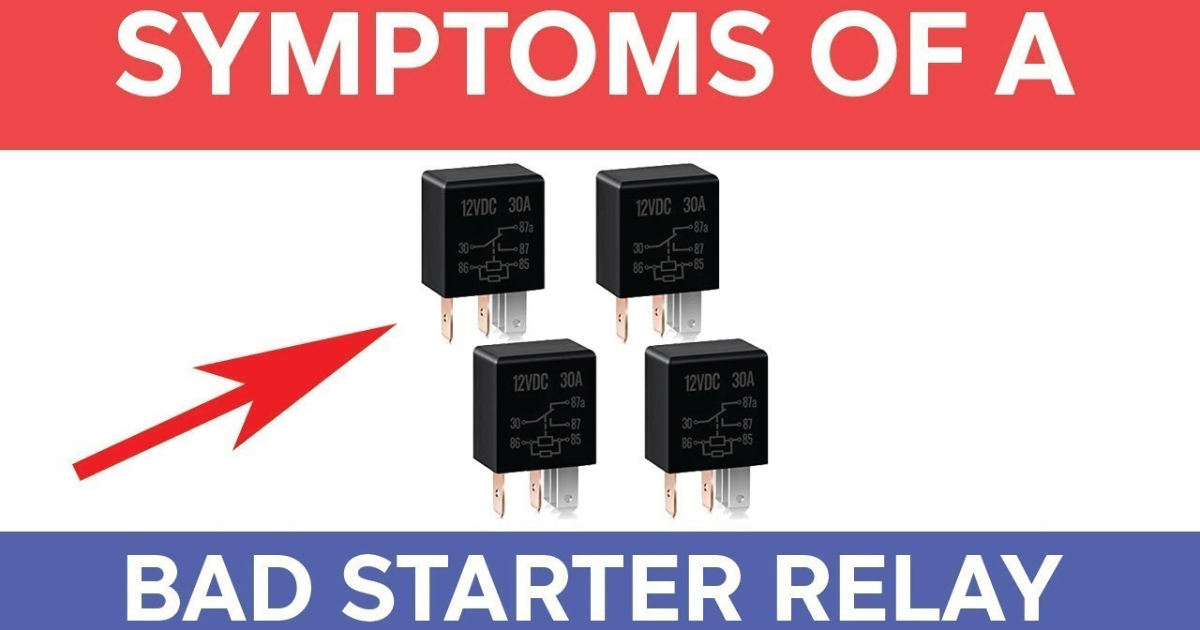Know the indicators of a faulty starting relay to avoid getting lost. The starter relay is crucial but often overlooked in ignition systems.
This ignition component provides battery current to the starter solenoid to start the engine. It switches a car’s starter motor and solenoid.
Starter relay issues are unusual. Sometimes it fails and your car won’t start. Many things can cause a starter relay to fail. Corroded circuits, bridged contacts, moist relays, and aged relays are examples. When your starting relay fails or acts up, warning signs occur.
We’ll discuss these indicators and how to identify a damaged starter relay. We’ll discuss functions, failures, and repair or replacement.
Why would a starter relay be used?

A starting relay connects the car battery to the starter solenoid. This implies a starter solenoid-starter motor switch.
Only the car battery current is intended for starting. Most mechanics and car owners confuse starter relays and solenoids. The ignition system has two elements.
The starter solenoid functions as a connection actuation coil to transfer current to the starter motor. Starter solenoids touch the engine ring gear and starter pinion.
How do the starting relay, solenoid, and motor work? The starting relay powers the starter solenoid and motor when the ignition key is turned on.
A starter relay supplies modest power to the starter solenoid, which draws a lot from the car batteries when the ignition key is turned on. The solenoid drives the starter motor, which spins the flywheel.
All modern starters employ this method. The starter relay powers the solenoid and flywheel. The starter relay starts cars.
Signs of a defective starter relay
Let’s look at the symptoms below.
The car won’t start.
Most often, a defective starter relay prevents your automobile from starting. A broken starter relay may cause your car to not start or click when you turn it on and your inside lights are bright.
Starting relay that stays on after the engine starts
The starter relay and solenoid use ignition switch electricity. Solenoids start engines by turning the starter motor’s flexplate.
The starter solenoid and motor should stop when the ignition is off. If this fails, a faulty starting relay keeps the relay on after the engine starts. The relay may send a steady current.
It usually happens when the relay touches or powers. To avoid commencing system harm, diagnose and fix this promptly.
A quick succession of clicks from the starting
No crank means the relay isn’t sending enough electricity to the starter motor. This also indicates a dead battery. Only when it gives enough electricity to the starter does the relay work. Low power may harm the starter mechanism or prevent your car from starting, or clicking.
Rusty relay contact points can cause both. To restore flow, clean contact points or replace an obsolete relay. Sandpaper or sand scraper can clean rusted relays. Replace the relay to boost output.
How is a start relay troubleshooted?

Test starter relay circuitry to determine the problem’s cost. Starter relay diagnosis is simple due to its location. Proper tools and knowledge are enough.
Materials needed:
- screwdrivers to test lights.
- A jumper wire
- Wrenches and sockets (for loss)
Testing starter relay
Charge your battery and grab a portable jumper cable before the exam. You can also check your car battery to make sure it’s charged and not the problem. Be careful when testing and placing jumper cables on battery connections.
The testing methods
Locate the starter relay fuse. Different vehicles have different fuse locations. Most fuses are near the battery, connecting to the positive terminal.
Allow an aide to turn the ignition key on. Electrical resistance testing is needed if you hear a weak click. If you hear a click, check the starter relay for voltage drop.
Electrical resistance diagnosis
- Set a multimeter or test light on the ohms scale. Contact one earth lead probe and one ignition circuit terminal probe. Startup relays should be below 5 ohms. Any reading higher indicates a relay failure.
- The second approach for diagnosing resistance is connecting the red multimeter probe to the ignition circuit wire and the other to the ground wire. If it reads less than 12V when you turn on the ignition, the relay is bad.
- Portable jumper cables are our third and final electrical resistance testing method. Connect battery and ignition circuit leads. A powerful relay click indicates good operation. One or two feeble clicks indicate a faulty relay that needs replacement.
Diagnostics for voltage decrease
- Reset your multimeter to 20V DC.
- Touch the multimeter’s red probe to the battery’s red terminal. Attach the black, thin wire to the ignition circuit lead switch.
- As you check the multimeter, tell your assistant to turn the ignition key on. Limit voltage to 0.2V. If the multimeter reads above 0.2V, the starter relay is faulty or has electrical conductivity issues that need correction. You must clean and inspect connectors.




